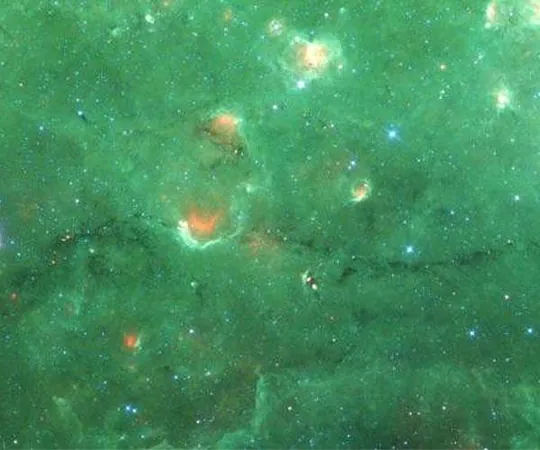
Robotic Telescopes Set to Transform Milky Way Mapping: A Revolutionary Leap in Astronomy!
2025-01-15
Author: Rajesh
In a groundbreaking initiative, the Sloan Digital Sky Survey (SDSS) has embarked on its most sophisticated spectroscopic survey to date, aiming to craft an intricate map of the interstellar material residing in our Milky Way Galaxy. This innovative project signifies a major leap forward in the field of astronomy, as researchers harness advanced robotic technology to unlock the secrets of our cosmic neighborhood.
Dhanesh Krishnarao, an Assistant Professor of Physics at Colorado College and a key figure in the SDSS team, expressed his excitement: “Our observing robots have been tirelessly working for a few years now, and they are about to change the way we scan the skies.” The initiative centers around the Local Volume Mapper (LVM) project, which employs cutting-edge telescopes located at the Las Campanas Observatory in the Atacama Desert of Chile—one of the best astronomical observation sites on Earth due to its clarity and elevation.
Understanding the Milky Way: More Than Just Stars!
As Dr. Niv Drory, head of the LVM program, elaborated, “The Milky Way is far more complex than merely a collection of stars; it is a dynamic environment filled with interstellar gas and dust that significantly contributes to galactic evolution.” The interplay between these substances and stars—as they are enriched with heavy elements through stellar winds and cataclysmic supernova explosions—forms the building blocks for future generations of stars and planets, ultimately influencing the creation of life itself.
Traditional telescopes primarily focus on distant galaxies, often missing the intricate details necessary to study local stars and their environments. However, the unique design of the LVM telescopes offers the capability to probe these nearby gaseous regions in detail across vast areas of the sky—an ambitious task that has now become a reality.
A Global Mapping Campaign: Ready to Launch!
With formal operations kicking off in late 2023, the LVM project aims to produce a comprehensive map of the interstellar material within the Milky Way. One notable advancement is the complete automation of the telescope operations, which means that no onsite personnel are required. Instead, a virtual international team of students and faculty will manage the system, often working from their local time zones.
Evelyn Johnston, the LVM Survey Operations Scientist, highlighted an impactful educational component: “The active participation of students during the commissioning, testing, and initial operations of the telescopes is a unique aspect of SDSS-V, which is shaping the next generation of astronomers versed in survey-based research.” This integrative approach not only advances knowledge but also inspires future scientists.
Robotic observations facilitate real-time monitoring without the traditional overnight shifts that often accompany astronomical research. According to Kathryn Kreckel, lead author of the project’s inaugural scientific paper, “The Local Volume Mapper enables us to establish critical connections between individual stars and their surrounding gas—an essential piece necessary for grasping how galaxies evolve.”
Unveiling the Data: A New Era for Astronomical Research!
The wealth of data generated by the SDSS, including insights from the LVM, is set to be made publicly available, with the initial dataset expected in the summer of 2025. This initiative promises to provide astronomers with unprecedented access to astronomical information, pushing the boundaries of knowledge in the field.
Moreover, the SDSS-V initiative is committed to increasing diversity within the realm of astronomy through its Faculty and Student Team (FAST) program. This initiative offers financial assistance and mentorship to students and faculty from minority-serving institutions, ensuring they are integral partners in this pioneering endeavor.
As Krishnarao noted, “The LVM data will furnish a fresh perspective on the structure of our Milky Way, and our FAST teams are poised to make significant contributions right from the start.”
In summary, the innovations stemming from the robotic SDSS telescopes not only promise to revolutionize how we map our galaxy; they also embody a commitment to inclusivity and education in the scientific community, potentially shaping the future of astronomy for decades to come. Stay tuned for more breakthrough revelations from the cosmos!


 Brasil (PT)
Brasil (PT)
 Canada (EN)
Canada (EN)
 Chile (ES)
Chile (ES)
 Česko (CS)
Česko (CS)
 대한민국 (KO)
대한민국 (KO)
 España (ES)
España (ES)
 France (FR)
France (FR)
 Hong Kong (EN)
Hong Kong (EN)
 Italia (IT)
Italia (IT)
 日本 (JA)
日本 (JA)
 Magyarország (HU)
Magyarország (HU)
 Norge (NO)
Norge (NO)
 Polska (PL)
Polska (PL)
 Schweiz (DE)
Schweiz (DE)
 Singapore (EN)
Singapore (EN)
 Sverige (SV)
Sverige (SV)
 Suomi (FI)
Suomi (FI)
 Türkiye (TR)
Türkiye (TR)
 الإمارات العربية المتحدة (AR)
الإمارات العربية المتحدة (AR)